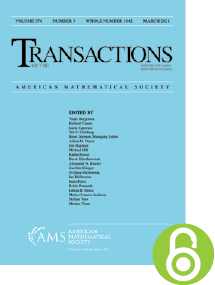Growth hyperspaces of Peano continua
HTML articles powered by AMS MathViewer
- by D. W. Curtis PDF
- Trans. Amer. Math. Soc. 238 (1978), 271-283 Request permission
Abstract:
For X a nondegenerate Peano continuum, let ${2^X}$ be the hyperspace of all nonempty closed subsets of X, topologized with the Hausdorff metric. It is known that ${2^X}$ is homeomorphic to the Hilbert cube. A nonempty closed subspace $\mathcal {G}$ of ${2^X}$ is called a growth hyperspace provided it satisfies the following condition: if $A \in \mathcal {G}$, and $B \in {2^X}$ such that $B \supset A$ and each component of B meets A, then also $B \in \mathcal {G}$. The class of growth hyperspaces includes many previously considered subspaces of ${2^X}$. It is shown that if X contains no free arcs, and $\mathcal {G}$ is a nontrivial growth hyperspace, then $\mathcal {G}\backslash \{ X\}$ is a Hilbert cube manifold. A corollary characterizes those growth hyperspaces which are homeomorphic to the Hilbert cube. Analogous results are obtained for growth hyperspaces with respect to the hyperspace ${\text {cc}}(X)$ of closed convex subsets of a convex n-cell X.References
- R. H. Bing, Partitioning a set, Bull. Amer. Math. Soc. 55 (1949), 1101–1110. MR 35429, DOI 10.1090/S0002-9904-1949-09334-5
- T. A. Chapman, On the structure of Hilbert cube manifolds, Compositio Math. 24 (1972), 329–353. MR 305432 —, All Hilbert cube manifolds are triangulable (preprint).
- T. A. Chapman, Lectures on Hilbert cube manifolds, Regional Conference Series in Mathematics, No. 28, American Mathematical Society, Providence, R.I., 1976. Expository lectures from the CBMS Regional Conference held at Guilford College, October 11-15, 1975. MR 0423357, DOI 10.1090/cbms/028
- D. W. Curtis and G. Kozlowski, Brick decompositions and $Q$-manifolds, Proc. Amer. Math. Soc. 72 (1978), no. 1, 170–174. MR 503555, DOI 10.1090/S0002-9939-1978-0503555-X D. W. Curtis and R. M. Schori, Hyperspaces of polyhedra are Hilbert cubes (submitted). —, Hyperspaces of Peano continua are Hilbert cubes (submitted).
- D. W. Curtis and R. M. Schori, Hyperspaces which characterize simple homotopy type, General Topology and Appl. 6 (1976), no. 2, 153–165. MR 394684, DOI 10.1016/0016-660X(76)90029-5
- Michael Handel, On certain sums of Hilbert cubes, General Topology and Appl. 9 (1978), no. 1, 19–28. MR 482774, DOI 10.1016/0016-660X(78)90039-9
- J. L. Kelley, Hyperspaces of a continuum, Trans. Amer. Math. Soc. 52 (1942), 22–36. MR 6505, DOI 10.1090/S0002-9947-1942-0006505-8 Sam B. Nadler, Jr., J. Quinn and Nick M. Stavrakas, Hyperspaces of compact convex sets (preprint).
- R. M. Schori and J. E. West, The hyperspace of the closed unit interval is a Hilbert cube, Trans. Amer. Math. Soc. 213 (1975), 217–235. MR 390993, DOI 10.1090/S0002-9947-1975-0390993-3
- R. M. Schori and J. E. West, Hyperspaces of graphs are Hilbert cubes, Pacific J. Math. 53 (1974), 239–251. MR 367892, DOI 10.2140/pjm.1974.53.239 H. Torunczyk, Concerning locally homotopy negligible sets and characterization of ${l_2}$-manifolds, Fund. Math. (to appear).
- Frederick A. Valentine, Convex sets, McGraw-Hill Series in Higher Mathematics, McGraw-Hill Book Co., New York-Toronto-London, 1964. MR 0170264
- James E. West, The subcontinua of a dendron form a Hilbert cube factor, Proc. Amer. Math. Soc. 36 (1972), 603–608. MR 312449, DOI 10.1090/S0002-9939-1972-0312449-9 M. Wojdyslawski, Retractes absolus et hyperespaces des continus, Fund. Math. 32 (1939), 184-192. Raymond Y. T. Wong, Non-compact Hilbert cube manifolds (preprint).
Additional Information
- © Copyright 1978 American Mathematical Society
- Journal: Trans. Amer. Math. Soc. 238 (1978), 271-283
- MSC: Primary 54B20; Secondary 54F25, 57N20
- DOI: https://doi.org/10.1090/S0002-9947-1978-0482919-1
- MathSciNet review: 482919


